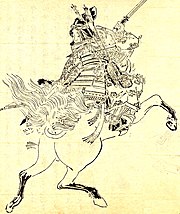Tomoe Gozen
From Wikipedia, the free encyclopedia

Tomoe Gozen (巴 御前 ) (1157?–1247?) was one of the few examples of a true female warrior samurai in all of Japanese history. She was a samurai during the time of the Genpei War (1180–1185). Her name is pronounced [tomoe].
- Tomoe was especially beautiful, with white skin, long hair, and charming features. She was also a remarkably strong archer, and as a swordswoman she was a warrior worth a thousand, ready to confront a demon or a god, mounted or on foot. She handled unbroken horses with superb skill; she rode unscathed down perilous descents. Whenever a battle was imminent, Yoshinaka sent her out as his first captain, equipped with strong armor, an oversized sword, and a mighty bow; and she performed more deeds of valor than any of his other warriors.
- —Tale of the Heike, translated by Helen McCullough, page 291.
After defeating the Heike and driving them into the western provinces, Minamoto no Yoshinaka (Tomoe's master) took Kyoto and desired to be the leader of the Minamoto clan. His cousin Minamoto no Yoritomo was prompted to crush Yoshinaka, and sent his brothers Minamoto no Yoshitsune and Minamoto no Noriyori to kill him. Yoshinaka fought Yoritomo's forces at the Battle of Awazu on February 21, 1184, where it has been said that Tomoe Gozen took at least one head of the enemy. Although Yoshinaka's troops fought bravely, they were outnumbered and overwhelmed. When Yoshinaka was defeated there, with only a few of his soldiers standing, he told Tomoe Gozen to flee because he wanted to die with his foster brother Imai no Shiro Kanehira and he said that he would be ashamed if he died with a woman.
There are varied accounts of what followed. One is that she was seen fleeing the field with the head of an enemy samurai. Afterwards there is even more uncertainty, some say that she gave up the sword. It is also said that she was defeated by Wada Yoshimori and became his wife. After Wada died, she was said to have become a nun in Echizen. These different stories are what give the story of Tomoe Gozen its intrigue. She was never proven to have been a historical figure so she could also be an invention of the author of Heike Monogatari. However, the grave of Yoshinaka's other female attendant Yamabuki Gozen does exist and most of the incidents in Tale of the Heike are believed by historians to be true.
Contents |
[edit] Tomoe in the media
As one of the very rare examples of warrior women in Japanese history, Tomoe has been incarnated as characters in several anime.
- In the 2005 NHK taiga drama Yoshitsune, Tomoe Gozen was one of the main characters. She was portrayed by actress and model Koike Eiko.
- Jessica Amanda Salmonson wrote "The Tomoe Gozen Saga", a trilogy of fantasy novels respectively titled Tomoe Gozen, The Golden Naginata, and Thousand Shrine Warrior. The first was reissued in a corrected and revised edition as The Disfavored Hero. [1]
- Saisei, a character in the manga Samurai Deeper Kyo, turned out to be the resurrected Tomoe Gozen. She is accurately portrayed, wearing beautiful armor and being highly skilled with her naginata
- In the comic book Usagi Yojimbo, a major supporting character is Tomoe Ame, a female samurai loosely based on Tomoe Gozen.
- Tomoe Gozen is the Persona of Chie Satonaka in the video game Persona 4.
- Tomoe Gozen is also mentioned several times in the book Young Samurai Way of the Warrior.
[edit] "Gozen"
Note that the title gozen is not a surname. Instead it is an honorific applied usually to women, but sometimes also men (Tomoe-gozen).
[edit] References
- Bella Online
- Famous Women of Japanese History
- Samurai Warriors: Miyamoto Musashi and Tomoe Gozen
- (Japanese) Modes of Address
- Woodblock print of Tomoe Gozen in battle
McCullough, Helen Craig (translator). The Tale of the Heike. Palo Alto, California: Stanford University Press, 1988. ISBN 0-8047-1418-5, ISBN 0-8047-1803-2.


